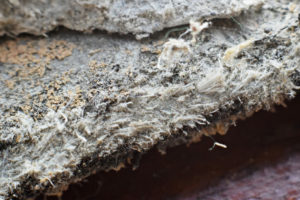Asbestosis
Asbestosis is a chronic lung condition caused by exposure to asbestos fibers. Symptoms include shortness of breath, chest pain, and a dry cough. While it is not cancer, asbestosis can be fatal and increases the risk of lung cancer and other serious conditions. We can help asbestosis patients explore treatment options and afford care.
What Is Asbestosis?
 Asbestosis occurs when lung tissue becomes scarred from asbestos, making it harder to breathe over time. The damage to the lungs constricts them and prevents oxygen from circulating through the body.
Asbestosis occurs when lung tissue becomes scarred from asbestos, making it harder to breathe over time. The damage to the lungs constricts them and prevents oxygen from circulating through the body.
Those who develop asbestosis also have an increased risk of asbestos lung cancer and mesothelioma.
Asbestosis Key Facts
- Asbestosis definition: A lung disease caused by exposure to asbestos
- Common symptoms: Cough, shortness of breath, clubbing of fingers and toes
- Treatments: Medications to ease pain, supplemental oxygen, pulmonary rehabilitation, and lung transplants in rare cases
- Prognosis (health outlook): Progresses over time and typically fatal within 5 years
If you or a loved one has asbestosis, you can pursue compensation to help pay for medical treatments and other expenses. Find out if you qualify with a free case review.
- Access Financial Aid and Justice
- Learn About Your Options
- Contact Us for Free

Asbestosis vs. Mesothelioma
Asbestosis is not the same as mesothelioma, though both are caused by asbestos exposure.
Mesothelioma is a cancer that develops in the linings of the lungs and other organs, while asbestosis is a noncancerous condition that directly affects the lungs.
Millions of people are at risk of asbestosis and mesothelioma because makers of asbestos-based products failed to warn of the risks for decades.
Asbestosis Causes


The only cause of asbestosis is asbestos. When asbestos dust is breathed in, fibers can settle in the alveoli (tiny sacs in the lungs where oxygen replaces carbon dioxide in the blood).
The fibers cause long-term irritation and the lung tissue hardens into scar tissue. It is at this point that asbestosis develops.
Who Is at Risk of Asbestosis?
Anyone exposed to asbestos is at risk of asbestosis later in life. Those in the greatest danger worked with or around asbestos at their jobs.
Those at a high risk of asbestos exposure include:
- Boilermakers
- Construction workers
- Electricians
- Factory workers
- Firefighters and first responders
- Mechanics
- Plumbers
- Shipyard workers
- Military service members
Family members of these workers could have also been exposed to asbestos secondhand. This happens when workers unknowingly bring asbestos fibers home on clothing, hair, and skin.
What Are the Symptoms of Asbestosis?
Asbestosis symptoms often do not appear until a long period of time has passed after exposure (typically 10-50 years). Symptoms can range from mild to severe and sometimes are mistaken for less serious conditions at first.
Common symptoms of asbestosis may include:
- A dry, persistent cough
- Chest pain and tightness
- Crackling sounds when breathing
- Clubbing of toes and fingernails
- Shortness of breath
- Trouble breathing
- Unintended weight loss from lack of appetite
- Wheezing
Catching symptoms early is key to receiving treatment and easing discomfort.
Have symptoms of asbestosis? You may be eligible for compensation to help cover treatment costs. Call (877) 446-5767 now.
Asbestosis Diagnosis


Asbestosis tests may include:
- Chest X-rays
- CT scans
- Lung function tests
These tests can show scarring of the lung tissue — a hallmark sign of asbestosis — and determine how well your lungs are working. Specialists may also recommend a biopsy (test for cancer cells) to rule out lung cancer or mesothelioma.
Diagnosed with asbestosis, lung cancer, or another asbestos-related disease? You may qualify for compensation. Get a free case review now to learn more.
- Access Financial Aid and Justice
- Learn About Your Options
- Contact Us for Free




Asbestosis Misdiagnosis
Doctors may misdiagnose asbestosis due to its similarities to other lung conditions.
Asbestosis could be misdiagnosed as:
- Interstitial lung disease
- Lung cancer
- Malignant mesothelioma
- Other diseases of the lungs or pleura (lung lining)
If you’re misdiagnosed, you may not get the health care you need and your condition could worsen. Get a second opinion if you believe you may have been misdiagnosed.
Asbestosis Prognosis
Prognosis measures how long you’re projected to live with a specific condition or illness.
The average asbestosis prognosis is 4 years or less, according to the U.S. National Library of Medicine. If asbestosis is severe enough, a patient may not live past a year.
Talk to your health care team to get a better understanding of your prognosis and life expectancy following an asbestosis diagnosis.
Asbestosis Treatments
While there is no cure for asbestosis, patients can manage symptoms and live longer by getting treatment.
Common treatment options for asbestosis include:
- Antifibrotic drugs: These medications preserve lung function. A 2022 Respiratory Research study found that one such drug, pirfenidone, could potentially slow the progression of the disease.
- Quitting smoking: Cigarette smoke worsens symptoms of asbestosis. Doctors recommend quitting immediately.
- Oxygen therapy: Supplemental oxygen can improve breathing and organ function. It can be received at home or in a hospital.
- Pulmonary rehabilitation: Tests, exercises, and nutrition counseling are used to assess and improve lung capacity.
- Lung transplant surgery: This is only performed as a last resort. Most patients won’t qualify if they have other lung diseases or are in poor overall health.
Talk to your doctor to learn which asbestosis treatments could work best in your case.
Compensation Options for Asbestosis
Asbestosis treatments can be expensive, but Lung Cancer Group can help you pursue asbestos compensation to help cover the costs and any other bills.
Explore asbestosis compensation options below and find out your eligibility.
Asbestosis Lawsuits
You or a loved one may qualify to file asbestosis lawsuits or legal claims to pursue financial compensation from asbestos companies. Some asbestos lawsuits have awarded over $1 million.
Get a free case review and connect with asbestosis lawyers who can file a lawsuit for you, if eligible.
- Access Financial Aid and Justice
- Learn About Your Options
- Contact Us for Free




Asbestos Trust Fund Claims
Asbestos trust funds contain money set aside by companies that filed for bankruptcy to avoid lawsuits. There’s over $30 billion in total in these funds today.
Our partner asbestos law firm can help you file trust fund claims and asbestosis legal claims to get the highest payouts possible. Call (877) 446-5767 to find out if you qualify.
VA Benefits for Asbestosis
Veterans are at a high risk of asbestosis since the military used asbestos until the early 1980s, before the dangers were publicly known. The U.S. Department of Veterans Affairs (VA) offers benefits to veterans with asbestosis and other asbestos-related diseases.
Notable VA benefits include:
- Disability payouts worth thousands of dollars a month
- Free or inexpensive health care
- Survivor benefits
These VA benefits can make life easier for U.S. veterans fighting lung cancer, allowing them to find and afford care.
Get Help For Asbestosis
Receiving an asbestosis diagnosis may feel overwhelming, but the condition can be manageable with medical care, allowing you to live for many years after a diagnosis.
Lung Cancer Group can help you or someone you love who may be suffering from asbestosis.
Work with our team to:
- Better understand asbestosis and your treatment options
- File asbestos claims to seek compensation for treatments
- Secure justice for other asbestos diseases like lung cancer
Our patient advocates are ready to assist you or someone you love after an asbestosis diagnosis.
Get a free case review today to see how we can help you.
Asbestosis FAQs
What is the life expectancy of someone with asbestosis?
The typical life expectancy for asbestosis patients is 4 years or less, according to a report from the U.S. National Library of Medicine.
Asbestosis worsens lung function over time, but treatment may slow its course, which can help you live longer.
What causes asbestosis?
Asbestos exposure causes asbestosis. If asbestos fibers get trapped in the lungs, it can lead to long-term inflammation and scarring.
This eventually causes asbestosis 10-50 years after the first exposure.
Can you cure asbestosis?
No, asbestosis cannot be cured, but treatments like oxygen therapy and pulmonary rehabilitation can improve your quality of life.
If your asbestosis worsens over time, contact your care team. They can adjust your treatment to help manage your symptoms.
Contact us now for help affording treatments for asbestosis.
What are the first signs of asbestosis?
Common first signs and symptoms of asbestosis include:
- Chest pain or tightness
- Persistent dry coughing
- Shortness of breath
Signs of asbestosis vary by person, and they may be mistaken for those of a more common and less severe illness at first (like the flu).
For this reason, make sure to see a doctor if you were exposed to asbestos and develop any of these symptoms later in life.
What are the stages of asbestosis?
A report from The Clinical Respiratory Journal outlines three stages of asbestosis. Patients with stage I (the least advanced stage) had better overall lung function compared to those with stage II or stage III asbestosis.
A doctor can determine your stage at the time of diagnosis and recommend treatments to help.

